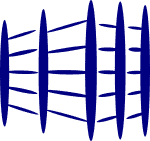It is correct it is inevitable, however with this formula you can calculate the depth of its frames and thus avoid residues and inefficiencies.
a) Depth of a sku: where a is the width of the aisle, q is the number of pallets to store of a sku and z is the height in number of pallets:
√((a/2)(qi/zi))
b) Pallet flow rack. To minimize the average floor space consumed per
pallet, pallet flow rack should be configured with lane depth of approximately:
√(a(1/n)(Σ(qi/zi)desde from i to n)
c) Floor storage room. To minimize the average space consumed per pallet,
floor storage should be configured with a lane depth of approximately:
√((a/2)(1/n)(Σ(qi/zi)desde from i to n)
where a is the width of the aisle, q is the number of pallets to store of a sku and z is the height in number of pallets.



